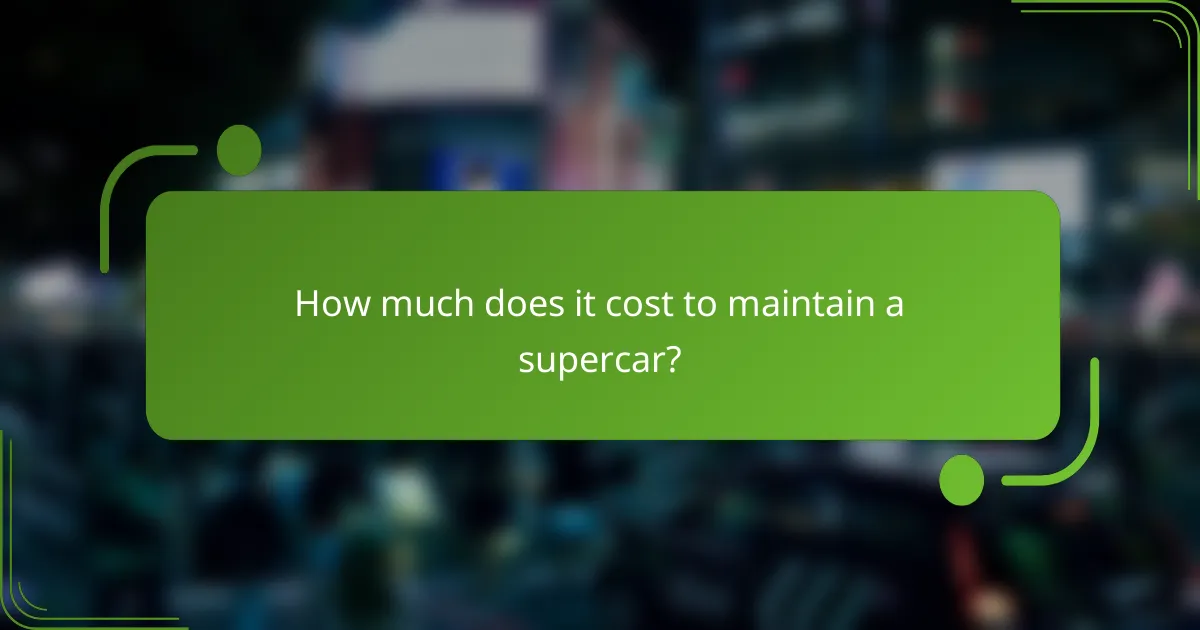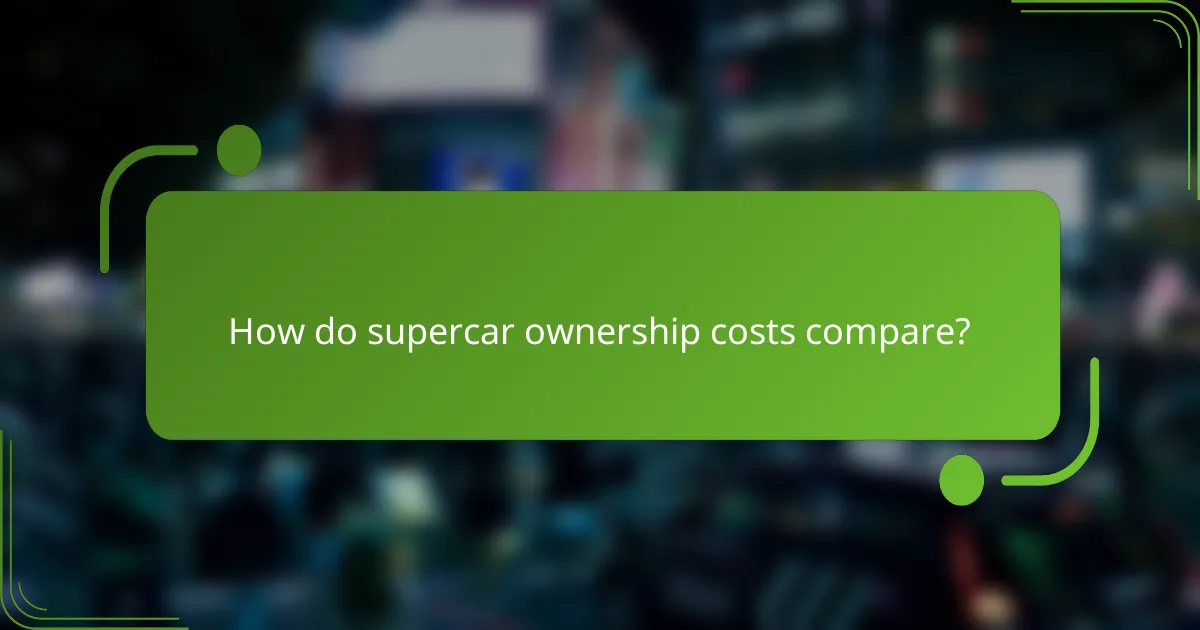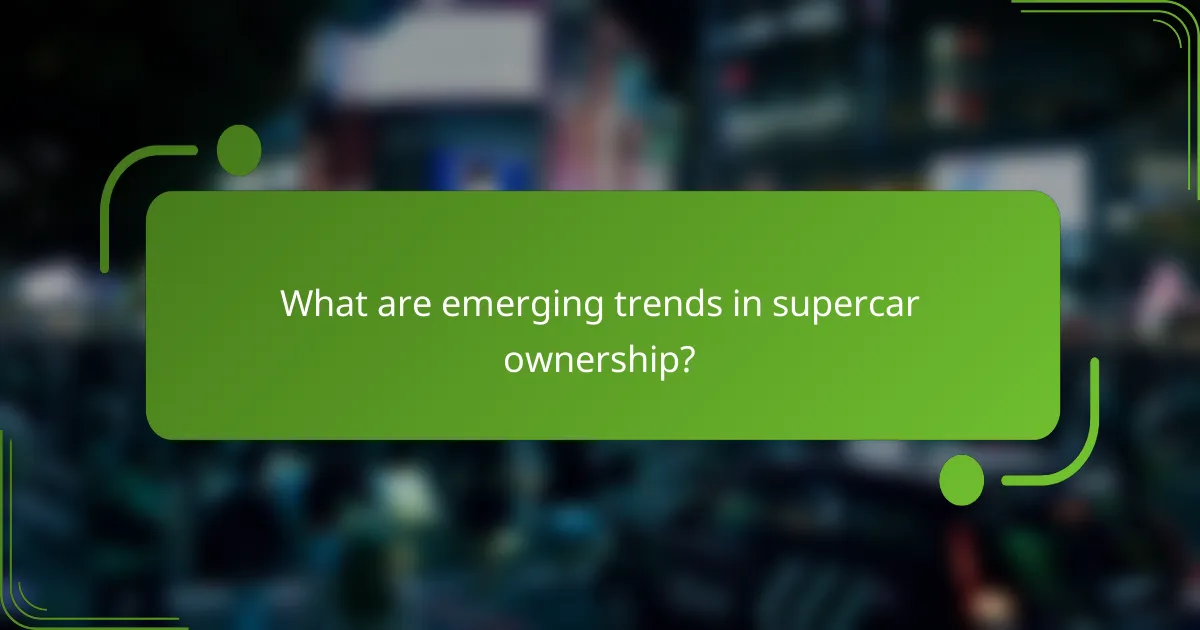Owning a supercar comes with unique financial considerations, including luxury taxes that can elevate both the purchase price and ongoing costs. Maintenance expenses can range from thousands to tens of thousands of dollars annually, influenced by various factors such as the vehicle’s make and model. Additionally, selecting the right storage solution is crucial for preserving the car’s condition and value, ensuring it remains protected from environmental elements and secure from potential threats.

What are the luxury taxes on supercars in Canada?
In Canada, luxury taxes on supercars are imposed at both the federal and provincial levels, affecting the overall cost of ownership. These taxes can significantly increase the purchase price and ongoing expenses associated with high-value vehicles.
Provincial sales tax implications
Each province in Canada has its own sales tax regulations that apply to supercars. For instance, provinces like British Columbia and Ontario have a provincial sales tax (PST) that can range from 7% to 10% on the purchase price of the vehicle. Buyers should factor in these additional costs when budgeting for a supercar.
In some provinces, the sales tax is calculated on the full price of the vehicle, while others may have exemptions or reduced rates for certain types of vehicles. It’s crucial to check the specific tax rates and regulations in your province before making a purchase.
Luxury tax rates for high-value vehicles
In addition to provincial sales tax, Canada has implemented a luxury tax on vehicles priced above a certain threshold, typically around CAD 100,000. This tax can be up to 20% on the portion of the vehicle’s price that exceeds this limit. For example, if a supercar costs CAD 150,000, the luxury tax would apply to CAD 50,000, resulting in a tax of up to CAD 10,000.
Understanding these luxury tax rates is essential for potential buyers, as they can significantly impact the total cost of ownership. It’s advisable to consult with a tax professional or dealership to get a clear picture of the financial implications.
Impact of carbon emissions tax
Supercars often come with high carbon emissions, which can trigger additional taxes under Canada’s carbon pricing system. Depending on the province, this tax can add to the overall cost of ownership, especially for vehicles that exceed specific emissions thresholds. The carbon tax can vary, but it may be calculated based on the vehicle’s fuel consumption and emissions output.
Buyers should consider the environmental impact and potential carbon taxes when selecting a supercar. Opting for models with lower emissions may not only reduce tax liabilities but also align with sustainability goals.

How much does it cost to maintain a supercar?
Maintaining a supercar can be quite expensive, with annual costs often ranging from several thousand to tens of thousands of dollars. Factors such as the make and model, driving habits, and local service rates all play a significant role in determining these expenses.
Average annual maintenance costs
The average annual maintenance costs for supercars typically fall between $2,000 and $10,000, depending on the vehicle’s brand and age. Luxury brands like Ferrari or Lamborghini may see higher costs due to specialized parts and service requirements.
Regular maintenance, including oil changes, tire rotations, and inspections, can contribute significantly to these expenses. Budgeting for unexpected repairs is also crucial, as supercars often require more frequent attention than standard vehicles.
Common repairs and their costs
Common repairs for supercars can include brake replacements, tire changes, and engine servicing. Brake replacements can range from $1,500 to $5,000, while tire sets may cost between $1,000 and $3,000 depending on the brand and performance specifications.
Engine repairs or replacements can be particularly costly, often exceeding $10,000. It’s essential to have a trusted mechanic familiar with supercars to avoid inflated costs and ensure quality service.
Factors affecting maintenance expenses
Several factors influence the maintenance expenses of supercars, including the vehicle’s age, mileage, and the type of driving it undergoes. Older models may require more frequent repairs, while high-mileage vehicles often face increased wear and tear.
Additionally, the availability of parts and the expertise of local mechanics can impact costs. In regions with fewer specialized service centers, owners may face higher labor rates and longer wait times for parts, further driving up maintenance expenses.

What are the best storage options for supercars?
The best storage options for supercars prioritize protection from environmental factors, security, and accessibility. Choosing the right storage solution can help maintain the vehicle’s condition and value over time.
Climate-controlled storage facilities
Climate-controlled storage facilities are ideal for supercars as they maintain a consistent temperature and humidity level, protecting vehicles from extreme weather conditions. These facilities often feature advanced security systems and are designed to minimize dust and debris exposure.
When selecting a climate-controlled facility, consider factors such as location, cost, and the facility’s reputation. Monthly fees can vary widely, typically ranging from $150 to $500 depending on the amenities and services offered.
Home garage modifications
Modifying a home garage for supercar storage can enhance protection and convenience. Key modifications include installing climate control systems, upgrading flooring to prevent moisture damage, and adding security features like reinforced doors and surveillance cameras.
Consider using a dehumidifier and insulation to regulate temperature and humidity levels. Ensure the garage is spacious enough to accommodate the vehicle comfortably, allowing for easy access and maintenance.
Insurance considerations for storage
Insurance is a crucial aspect of supercar storage, as it protects against theft, damage, or loss. Ensure that your insurance policy covers the specific storage conditions, whether in a facility or a modified home garage.
Review your coverage limits and consider additional policies for high-value vehicles. Some insurers may offer specialized coverage options tailored for supercars, which can provide better protection at a reasonable cost.

What are the prerequisites for owning a supercar?
Owning a supercar requires significant financial investment, ongoing maintenance, and proper storage solutions. Prospective owners should be prepared for high purchase costs, substantial insurance premiums, and the need for secure, climate-controlled storage.
Financial requirements for purchase
The initial cost of a supercar typically ranges from the low hundreds of thousands to several million dollars, depending on the make and model. Beyond the purchase price, buyers should account for luxury taxes, which can vary significantly by country and even by state or province.
Additionally, potential owners should consider ongoing expenses such as maintenance, fuel, and tires, which can be considerably higher than those for standard vehicles. A good rule of thumb is to budget at least 10-15% of the car’s value annually for maintenance and related costs.
Insurance and registration needs
Insurance for supercars can be quite costly, often ranging from several thousand to tens of thousands of dollars per year, depending on the car’s value, the owner’s driving history, and coverage options. It’s advisable to seek specialized insurance providers that understand the unique needs of high-performance vehicles.
Registration requirements can also differ based on location, with some areas imposing additional luxury taxes or fees for high-value vehicles. Owners should check local regulations to ensure compliance and to avoid unexpected costs during the registration process.

How do supercar ownership costs compare?
Supercar ownership costs are significantly higher than those of typical luxury vehicles, encompassing luxury taxes, maintenance, and storage expenses. These costs can vary widely based on the make and model, but potential owners should be prepared for substantial ongoing financial commitments.
Comparison with luxury sedans
When comparing supercars to luxury sedans, the differences in ownership costs are stark. Luxury sedans typically incur lower insurance premiums, maintenance fees, and taxes, often ranging from a few hundred to a couple of thousand dollars annually. In contrast, supercar owners may face insurance costs that can exceed several thousand dollars per year, along with maintenance bills that can reach tens of thousands, especially for high-performance models.
Additionally, luxury sedans generally have better fuel efficiency, while supercars often require premium fuel, further increasing operational costs. Owners should also consider the depreciation rates, as luxury sedans tend to hold their value better than supercars, which can experience steep declines in value shortly after purchase.
Long-term value retention
Long-term value retention for supercars can be unpredictable, with some models appreciating over time while others depreciate quickly. Factors influencing this include brand reputation, rarity, and demand within the collector market. For instance, limited-edition models from prestigious brands may see value increases, while more common supercars may lose a significant portion of their value within the first few years.
To maximize value retention, potential buyers should research models known for their desirability and limited availability. Regular maintenance and proper storage can also play crucial roles in preserving a supercar’s condition, which directly impacts its resale value. Owners should be prepared to invest in both routine upkeep and secure storage solutions to maintain the vehicle’s appeal in the long run.

What are emerging trends in supercar ownership?
Emerging trends in supercar ownership reflect a shift towards sustainability, technology integration, and shared ownership models. Many buyers are increasingly considering electric supercars and subscription services as alternatives to traditional ownership.
Luxury taxes on supercars
Luxury taxes on supercars can significantly impact the overall cost of ownership. In many countries, these taxes are applied based on the vehicle’s price, often exceeding a certain threshold, which can lead to additional costs ranging from a few thousand to tens of thousands of dollars.
For instance, in the United States, some states impose a luxury tax on vehicles priced above a specific amount, while in Europe, countries like France and Italy have similar regulations. It’s essential for potential buyers to research local tax laws to understand the financial implications of their purchase.
Maintenance costs for supercars
Maintenance costs for supercars can be considerably higher than those for standard vehicles. Owners should expect to spend anywhere from several thousand to tens of thousands of dollars annually on routine maintenance, including oil changes, tire replacements, and specialized services.
Factors influencing maintenance costs include the make and model of the supercar, the frequency of use, and the availability of parts. Regular servicing at authorized dealerships is often recommended to maintain warranty coverage and ensure optimal performance.
Storage solutions for supercars
Proper storage solutions are crucial for preserving the condition of supercars. Owners should consider climate-controlled garages or specialized storage facilities that protect vehicles from extreme temperatures and humidity, which can lead to deterioration.
Additionally, investing in high-quality covers and security systems can safeguard against theft and environmental damage. It’s advisable to regularly check tire pressure and battery health, especially if the vehicle is stored for extended periods, to ensure it remains in peak condition when it’s time to drive.
